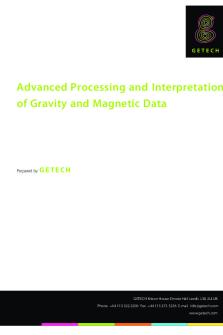HFD Interpretation PDF

| Title | HFD Interpretation |
|---|---|
| Author | aisha fatima |
| Course | Clinical Psychology |
| Institution | COMSATS University Islamabad |
| Pages | 42 |
| File Size | 800.9 KB |
| File Type | |
| Total Downloads | 3 |
| Total Views | 146 |
Summary
psychological assessmnet test...
Description
“HUMAN FIGURE DRAWING TEST”
DEFINITION A Projective measure is a psychological instrument that allows a clinical psychologist or a psychoanalyst to judge a person's capabilities and habits by projecting their thought process and emotional responses via their drawings and the images they are shown.
DEVELOPMENTAL HISTORY
The interest in drawings has a well documented history in Europe. Goodenough reports that , as early as 1885, an article appeared in England by Ebenzer Cooke in which he described developmental stages in children's drawings. Numerous other studies and papers by different psychologists and educators have followed since then over the past 75 years.
Over the years, the emphasis in the literature shifted from comparative investigations of graphic productions by children and primitive people to clinical analysis of paintings and drawings of disturbed children, to longitudinal studies of youngsters from their first scribble to mature drawings, and to the assessment of mental maturity by means of HFD.
BASIS
The Human Figure Drawing test is a non-verbal test, mainly based on visuo-spatial and constructional abilities. It underlies the theory of Machover(1949), Urban(1963), and Handler(1985). It is based on the Freud's theory of 'repression' and also effected by Sullivan's theory of interpersonal relationships.
It is stated that the HFD will reveal 'general conflicts and concerns' of the client when combined with other clinical information and assessment to determine general cognitive functioning.
METHOD
The HFD test requires that the test taker draws 'a whole person' at the request of examiner in his presence.
INTERPRETATON METHODS
Two main approaches for the interpretation of HFD exist today 1. clinicians who regard HFD as a projective technique and analyze drawings for the signs of unconscious needs, conflicts, and personality traits. 2. representative of the second school of thought approach HFD'S as a developmental test of mental maturity.
The drawings will be scored in two different types of objective signs: Developmental Items Emotional Indicators One set of signs on HFD is believed to be primarily related to children's age and level's of maturation. These signs are called the 'Developmental Items'.
Emotional indicators reflect the individual's anxieties, concerns, and attitudes. An emotional indicator has to meet three criteria:
Clinical validity (difference between HFD's of children with and without emotional problems.
It must be unusual and occur infrequently on the HFD's of who are not psychiatric patients.
It must not be related to age and maturation, i.e, its occurrence and frequency on HFD's must not increase solely on the basis of increase in age.
Instructions for HFD (Koppitz)
“ On this piece of paper, I would like you to draw a WHOLE person. It can be any kind of a person you want to draw, just make sure that it is a whole person and not a stick figure or a cartoon figure.”
1. Quality Signs: Broken or sketchy lines Poor integration of parts of figure Shading of the face or its parts Shading of the body and/or limbs Gross asymmetry of limbs Figure standing by 15 degrees or more Tiny figure, 2" or less in height Big figure, 9" or more in height transparencies
The Special Features:
Tiny head, 1/10th of total height of figure Large head, as large or large than body Vacant eyes, circles without pupils Side glances of both eyes, both eyes turned to one side Crossed eyes, both eyes turned inward Teeth Short arms, not long enough to reach waistline
Cont…
Long arms, that could reach below knee line Arms clinging to sides of body Big hands, as big as face Hands cutoff, arms without hands and fingers Hands hidden behind back or in pockets Legs pressed back or in pockets Legs pressed together
Cont… Genitals Monster or ghost like figure Three or more figures spontaneously drawn Figure cutoff by the edge of paper Baseline, grass, figure on edge of paper Sun or moon Clouds, rain, snow or flying birds
VALID EMOTIONAL INDICATORS
POOR INTEGRATION OF PARTS OR FIGURES Poor integration appears to be associated with any or several of the following: Instability A poorly integrated personality Poor coordination or impulsivity Poor Integration seems to indicate immaturity on the part of the child which may be the result of a developmental lag, neurological impairment, regression due to serious emotional disturbance or all of these.
Reznikoff and Tomblen found that this was associated with organicity in adults. Hamer attributes poor synthesis of HFD's to emotional disturbances.
Shading
Shading is a manifestation of anxiety
The degree of shading is related to the intensity of anxiety within the person.
Overtly aggressive/ stealing
Poor self concept
Shading of the body
Body anxiety Psychosomatic complaints Guilt feeling
hands: ands: Shading of the h
Anxiety related to the activities done by hands like guilt related to masturbatory activities, or stealing specifically shading of arms reflects guilt for aggressive impluses.
neck: Shading of the ne ck: Anxiety related to handling of stress Try to control anxious impulse Acting out behavior Shading Of legs: Anxiety about siz size e and ph physical ysical gr growth owth or concern about se sexual xual imp impulses ulses ulses..
Gross asymmetry of limbs limbs::
Aggressive Brain injured Poor coordination & impulsivity
Slanting figu figure: re:
Sense of instability Lack of balance
Tiny Figure
Depression Extreme sense of withdrawal Poor self image Big figure:
Aggressive Immature Poor inner control
Transparencies
Psychosomatic complaints Acting out behavior Immaturity Tiny head:
Hostile feeling towards others Poor achievement Maladjusted individual
Crossed Eyes
Paranoid ideation Inward eyes represents hostility & anger Teeth:
Aggressive Sadistic tendency if teeth were sharp Oral sex Short Arms:
Inadequacy towards task Difficulty in approaching others
Long Arms
Aggressively approaching others Striving for the need of affection, & love Arms clinging:
Defensive individual Good impulse control Paranoid schizophrenic Rigid & reserved Big Hand:
Aggressive Acting out Stealing things
Hand cut off:
Poor achievement Helplessness dependent Legs pressed:
Fear of attack Tension related to sexual activity Rejection of someone who approached them Genitals:
Acute body anxiety Psychopathology
Monster (Ghost)
Poor self control Environmental stress Inadequacy Three or more figures spontaneously drawn:
Need of dependency Poor school achievement Problem with their self identity Clouds, sun or moon:
Under pressure of authority figure
Snow or Moon Interpsychic conflict Omission of eyes:
Denial/ refusal of problem Limited social interest Omission of nose:
Shy/ withdrawal behavior Feeling of helplessness Castration anxiety/ masturbatory guilt
Psychosomatic complaints Depressed Anxiety/ insecurity Refused to communicate with others Omission of arms:
Depressed & helplessness Sexual guilt/ overt hostility
•
Omission of legs:
Insecurity Intense Anxiety Omission o off feet: Feeling of Insecurity Helplessness Hopeless attitude towards others
Omission of neck:
Psychosomatic complaints Immaturity Poor inner control
Non-Valid Emotional Indicators Big Head: Intellectual inadequacy Immaturity Migraine headaches
Vacant eyes or non-seeing eyes
Guilt feelings over voyeuristic tendencies Vague perception of the world Emotional immaturity Lack of discrimination Depression
Sideway glance of both eyes
Suspiciousness fear
Hidden hands
Contact difficulties Guilt Need to control aggression Unwillingness to deal with a situation
Figure cut off by the edge of the paper
Insecurity Poor coordination Weak inner control Poor judgment
Baseline or grass
Need for support Insecurity
The sun or moon
Parental love and support Controlling adult authority Psychosomatic complaints
Broken or sketchy lines
Fearfulness Insecurity Feelings of inadequacy Anxiety Stubbornness Negativism
Koppitz gave importance to following three things for interpretation of Emotional Indicators
What does he draw? A person has significant value. How does he draw? It represents self-image. Why does he draw? Expression of emotions.
Interpretation
The protocol of HFD displays that she manifests the signs of suspiciousness, verbally aggressive and poorly integrated personality. She also exhibits marks of psychosomatic complaints and guilt feelings over her aggressive impulses. Streaks of need for change are also displayed in the layout may be due to some serious emotional disturbances. She also reveals signs of fearfulness, insecurity, feelings of inadequacy, and stubbornness along with negativism...
Similar Free PDFs
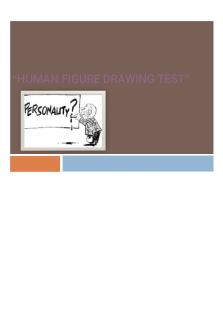
HFD Interpretation
- 42 Pages
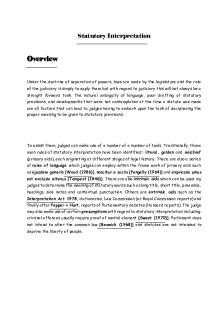
Statutory Interpretation
- 5 Pages

Statutory Interpretation
- 11 Pages
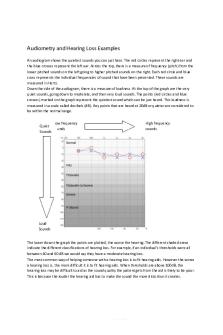
Audiogram Interpretation
- 12 Pages

Interpretation schreiben
- 2 Pages
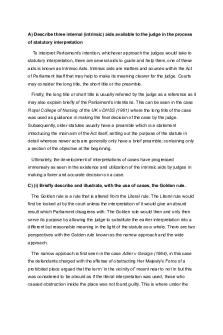
Statutory Interpretation
- 3 Pages

LFT Interpretation
- 5 Pages

Spirometry Interpretation
- 2 Pages

Statutory Interpretation
- 6 Pages

Statutory Interpretation
- 6 Pages

Statutory Interpretation
- 6 Pages

Statutory Interpretation Notes
- 9 Pages

Interpretation Act 1984
- 71 Pages

Internal Aids - Interpretation
- 44 Pages
Popular Institutions
- Tinajero National High School - Annex
- Politeknik Caltex Riau
- Yokohama City University
- SGT University
- University of Al-Qadisiyah
- Divine Word College of Vigan
- Techniek College Rotterdam
- Universidade de Santiago
- Universiti Teknologi MARA Cawangan Johor Kampus Pasir Gudang
- Poltekkes Kemenkes Yogyakarta
- Baguio City National High School
- Colegio san marcos
- preparatoria uno
- Centro de Bachillerato Tecnológico Industrial y de Servicios No. 107
- Dalian Maritime University
- Quang Trung Secondary School
- Colegio Tecnológico en Informática
- Corporación Regional de Educación Superior
- Grupo CEDVA
- Dar Al Uloom University
- Centro de Estudios Preuniversitarios de la Universidad Nacional de Ingeniería
- 上智大学
- Aakash International School, Nuna Majara
- San Felipe Neri Catholic School
- Kang Chiao International School - New Taipei City
- Misamis Occidental National High School
- Institución Educativa Escuela Normal Juan Ladrilleros
- Kolehiyo ng Pantukan
- Batanes State College
- Instituto Continental
- Sekolah Menengah Kejuruan Kesehatan Kaltara (Tarakan)
- Colegio de La Inmaculada Concepcion - Cebu

